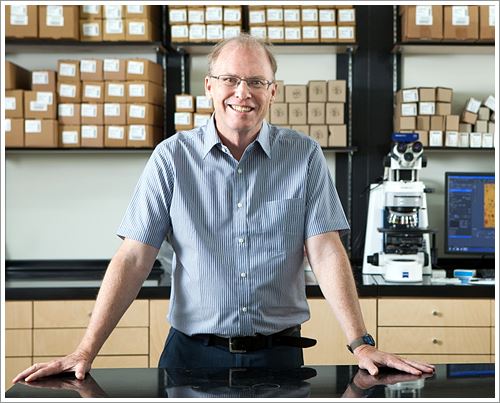Nanotechnology expert and physical chemist Rodney Ruoff will be joining the faculty this fall in the Department of Mechanical Engineering at The University of Texas at Austin.
Ruoff, whose most recent research on carbon-based materials will be published tomorrow in Nature, will hold the Cockrell Family Regents Chair in Engineering No. 7. He will conduct research on novel materials and devices in which the fields of chemistry, physics, biology, and engineering play a considerable role.

Rodney S. Ruoff, professor in the Cockrell School of Engineering’s Department of Mechanical Engineering
Since he undertook a Fulbright Fellowship at the Max Planck Institute in Goettingen, Germany, in 1989, Ruoff has become a leader in understanding the mechanical and chemical properties of carbon structures, such as fullerenes, which include the soccer ball-shaped form of carbon (C60), carbon nanotubes, and a new substance called graphene involving a single layer of carbon atoms.
His accomplishments presented in prestigious journals have included: the initial demonstration of the strength of individual carbon nanotubes, and research revealing how these tubes change shape from interacting with nearby molecules and surfaces.
In addition to investigating nanomaterials’ properties, Ruoff is known for providing visionary concepts and predictions, and for developing innovative experimental tools to manipulate and test nanomaterials and structures. These tools include a nanomanipulator-stage that holds nanotubes, silicon nanowires, and other small structures in configurations that allow their physical properties to be probed.
He has focused recently on developing a new class of materials, which he calls “graphene-based materials” that include graphene sheets (a single layer of carbon atoms) as a critical component. In 2006 while at Northwestern University, he and colleagues published a Nature article demonstrating that his laboratory could produce composite materials that included graphene sheets embedded in polymers such as polystyrene.
More recently, his team published an article in Nano Letters describing a transparent — but electrically conductive — thin film consisting of glass with embedded graphene sheets. The research was highlighted by Nature as a novel advance in materials science, with such thin conductive films potentially playing a role in applications such as solar cells and chemical sensors.
As a third novel effort on graphene-based materials, Ruoff and his team have demonstrated in a Nature article that will be published July 26 the high strength and flexibility of a paper-like material composed almost entirely of chemically modifiable graphene sheets. In the article, Ruoff and coauthors demonstrated that they could convert graphite into graphite oxide, which falls apart in water to become individual graphene sheets; after filtering the water, the team generated a paper-like material composed of stacked layers of graphene oxide that could be peeled from the filter.
This thin paper material provides versatility because of its ability to undergo further chemical modification and adjustment of its physical and chemical properties, thereby expanding the potential applications of graphene. Such “graphene-based paper” materials could be used as membranes, as super-strong and lightweight materials for aerospace structures and in cars, in wind turbines, and in energy storage applications such as batteries and supercapacitors.
After joining the Mechanical Engineering Department, Ruoff’s research will include investigating ways to chemically modify the properties of graphene oxide paper. He is currently the John Evans Professor of Nanoengineering in the Mechanical Engineering Department at Northwestern, where he directs the Biologically Inspired Materials Institute (a NASA institute). He joined Northwestern’s faculty in 2000, after serving as a physics faculty member at Washington University in St. Louis for four years.
